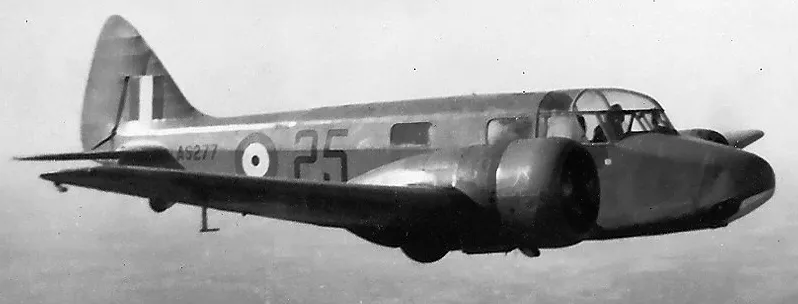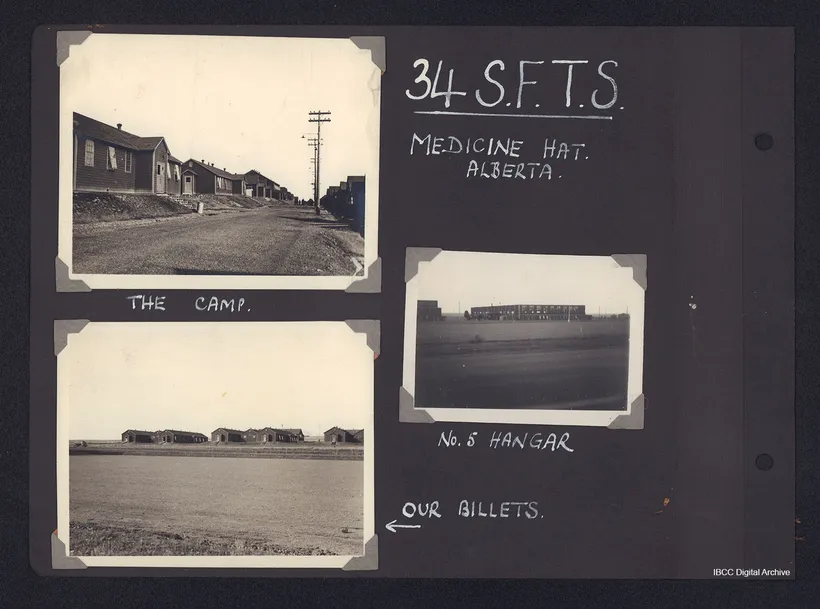Airspeed Oxford

Airspeed A.S. 10 Oxford Mk. II, RCAF (Serial No. AS277), 25, in flight over Saskatchewan, 1942.
The Airspeed AS.10 Oxford was a twin-engine monoplane aircraft developed and manufactured by Airspeed. It saw widespread use for training British Commonwealth aircrews in navigation, radio-operating, bombing and gunnery roles throughout the Second World War.
The Oxford was developed by Airspeed during the 1930s in response to a requirement for a capable trainer aircraft that conformed with Specification T.23/36, which had been issued by the British Air Ministry. Its basic design is derived from the company's earlier AS.6 Envoy, a commercial passenger aircraft. Performing its maiden flight on 19 June 1937, it was quickly put into production as part of a rapid expansion of the Royal Air Force (RAF) in anticipation of a large-scale conflict.
As a consequence of the outbreak of war, many thousands of Oxfords were ordered by Britain and its allies, including Australia, Canada, France, New Zealand, Poland, and the United States. Following the end of the conflict, the Oxford continued to achieve export sales for some time, equipping the newly formed air forces of Egypt, India, Israel, and Yugoslavia. It was considered to be a capable trainer aircraft throughout the conflict, as well as being used a general-purpose type. A large number of Oxfords have been preserved on static display. Wikipedia
CASPIR Aircraft Groups:
RCAF On Strength (821), Canadian Aircraft Losses (168)Oxford Mk. II AS831
Note that RAAF records also indicate this aircraft being delivered to Australia, used there continuously from October 1941 to at least March 1944! To No. 4 Training Command on 8 April 1942, for use by No. 34 Service Flying Training School at Medicine Hat, Alberta. Winter conversion set installed at No. 34 SFTS by 30 April 1942. Coded "110" at time of crash. Category A crash on 31 May 1942, 2 miles south of Holson relief field. Departed Medicine Hat at 14:25 for solo circuits, later reported overdue. Wreckage located at 20:00. Aircraft impacted ground at high speed, nearly vertically, with flaps and gear retracted and both engines running. Investigation could not find a definite cause of the crash. Cpl. R. Leprou, Free French AF, killed. Scrapped at No. 34 SFTS.
1941-11-12 Taken on Strength 2022-02-07
1942-May-31 Accident: 34 Service Flying Training School Loc: Holsom Relief Landing Ground Names: Leprou
1942-08-09 Struck off Strength Struck off, reduced to spares and produce 2019-08-20





 School Daily Diary Entry – 1942-05-31
School Daily Diary Entry – 1942-05-31 Find-A-Grave.com
Find-A-Grave.com Hillside Cemetery, Canada
Hillside Cemetery, Canada Oxford Trainer
Oxford Trainer Wikipedia Oxford Trainer
Wikipedia Oxford Trainer Harold A Skaarup Web Page
Harold A Skaarup Web Page
 RCAF.Info - RCAF Station Medicine Hat AB
RCAF.Info - RCAF Station Medicine Hat AB Bomber Command Museum Of Canada - 34 SFTS
Bomber Command Museum Of Canada - 34 SFTS